Most likely you are aware that the Kepler space telescope of the Kepler space telescope, specially designed for searching exoplanets, will run out in the coming days. Since 2013, due to accidents, it turned into a space sailing ship, but still continued to collect data. NASA has plans to collect some scientific information even after the end of the fuel, but by and large the mission will come to an end. But you should not get upset - the extension of the life of Kepler led to the fact that he waited for the next special apparatus, TESS, fulfilling the same goal - to search for planets in other star systems.

New old mission
TESS and Kepler are related not only to the task, but also the way to achieve it. Both telescopes search for exoplanets by the transit method - when a planet passes between a star and a telescope, its light is slightly damped.
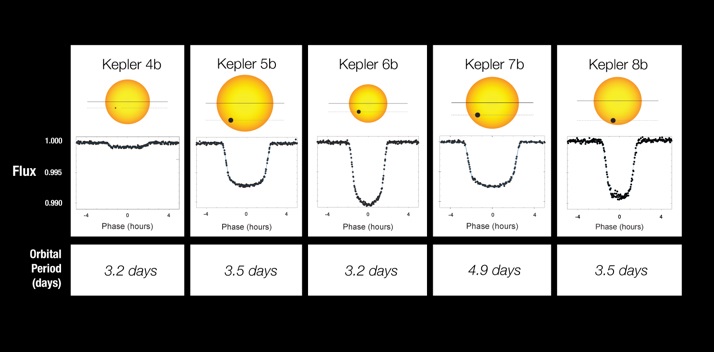 Charts brightness stars during the passage of exoplanets according to the Kepler telescope, drawing by NASA
Charts brightness stars during the passage of exoplanets according to the Kepler telescope, drawing by NASAThe method is good in that it is possible to determine not only the parameters of the orbit, but also the albedo (reflectivity) and even try to find out the composition of the atmosphere of an exoplanet by analyzing the change in the spectrum of a star. Alas, the transit method has its drawbacks - first of all, it is impossible to notice the planet if its plane of rotation does not pass through the “telescope-star” axis. In addition, the farther the planet is from the star, the greater its orbital period, and the longer it takes to continuously observe the star in order to notice the exoplanet. But in general, the comparative simplicity of the method and the ability to observe many stars at the same time allowed only the Kepler telescope to discover more than two and a half thousand exoplanets, and almost three thousand candidates are awaiting confirmation.
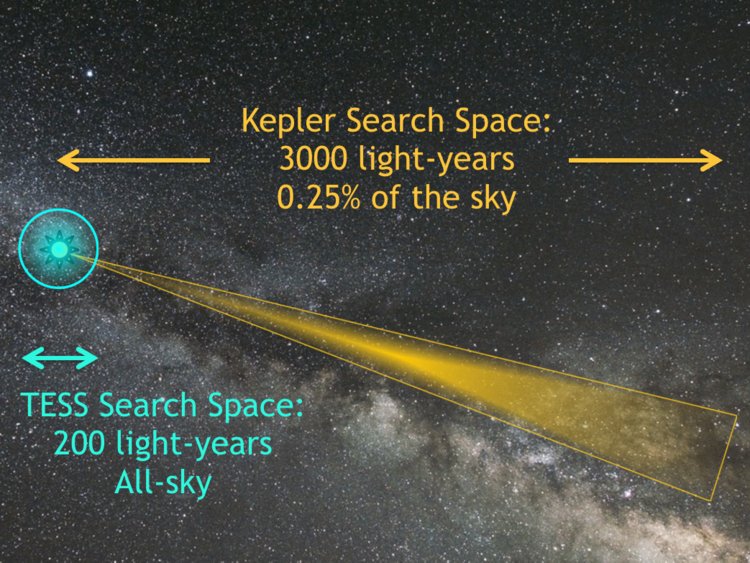 Comparison of Kepler and TESS visibility fields
Comparison of Kepler and TESS visibility fieldsBut then the differences begin - Kepler looks into a very narrow sector of space in the constellation Cygnus, but at a distance of up to 3000 light years. TESS "sees" only 200 light years away, but in two years the main mission will have to inspect both hemispheres. Every 27 days the telescope will switch to a new sector from the pole to 6 ° north / south latitude. It is easy to guess that the pole area will be under almost constant observation. This is potentially useful for future missions - there is a zone near the pole, which will be constantly available for observation of the not yet launched James Webb telescope.
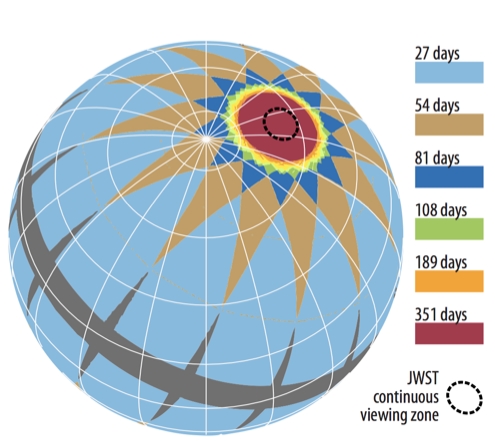 Image: NASA / TESS
Image: NASA / TESSNew eyes
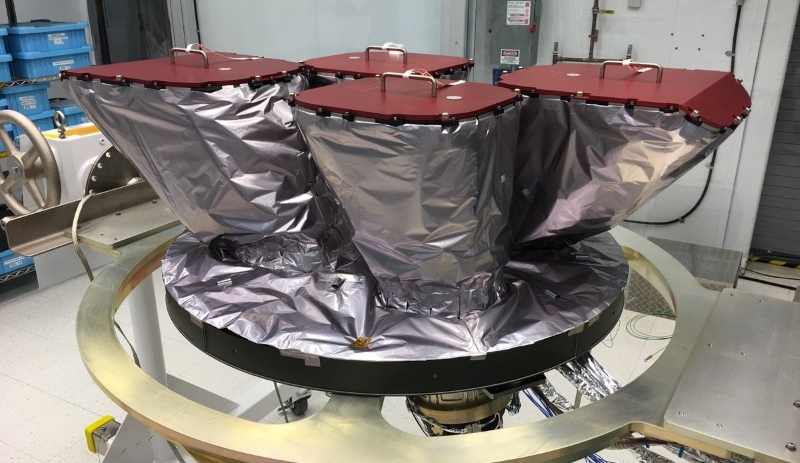 TESS cameras in the workshop, NASA photo
TESS cameras in the workshop, NASA photoThe only scientific instrument on TESS are four identical cameras. Each has a 16.8 megapixel sensor, an assembly of seven lenses and a special filter in the near infrared range to observe red dwarfs. A camera with an aperture of 146 millimeters and a relative aperture of f / 1.4 will see a 24x24 ° sector and will be able to take photographs with a resolution of 4096x4096 pixels.
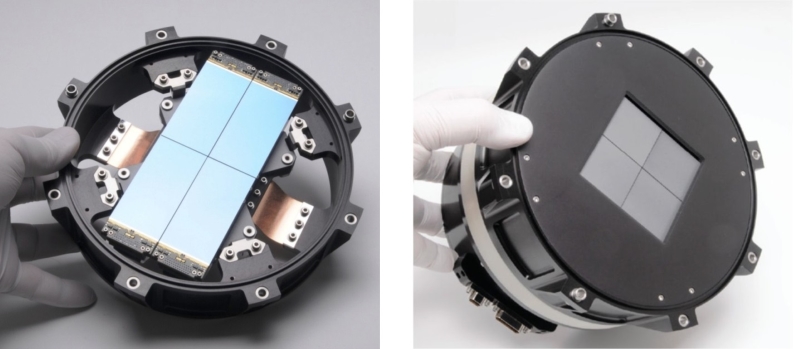 Sensor, hereinafter photos NASA / TESS Project
Sensor, hereinafter photos NASA / TESS Project Camera in section
Camera in section Camera assembly, man for scale
Camera assembly, man for scaleIt should be noted that TESS and Kepler belong to NASA programs with different levels of funding, so TESS is about two times cheaper.
Special orbit
In order for the TESS not to interfere with the Earth (in a low orbit it will not be possible to continuously look at one sector for 27 days), the device must be sent away from our planet. And in order to transmit data, it is desirable to be closer - with increasing distance antennas of larger diameter are required, and the speed drops. The geostationary orbit area is not suitable - the moon will interfere. Well, it is highly desirable to save money by making the telescope easier and simpler. And to solve all these problems, ballistics chose a very interesting orbit, which was not used before.
 TESS inference circuit, NASA image
TESS inference circuit, NASA imageAfter separation from the upper stage, TESS entered the reference orbit. In three turns, the device with its engines will raise the apocenter (the highest point of the orbit) so that it is in the area of the Moon. It was quietly saved here - maneuvering in one turn would have required more expensive and heavy engines. On the fourth turn, TESS will pass next to the Moon, taking advantage of its attraction in order to, firstly, move to a higher orbit, and secondly, change its inclination (a very expensive operation in terms of fuel consumption).
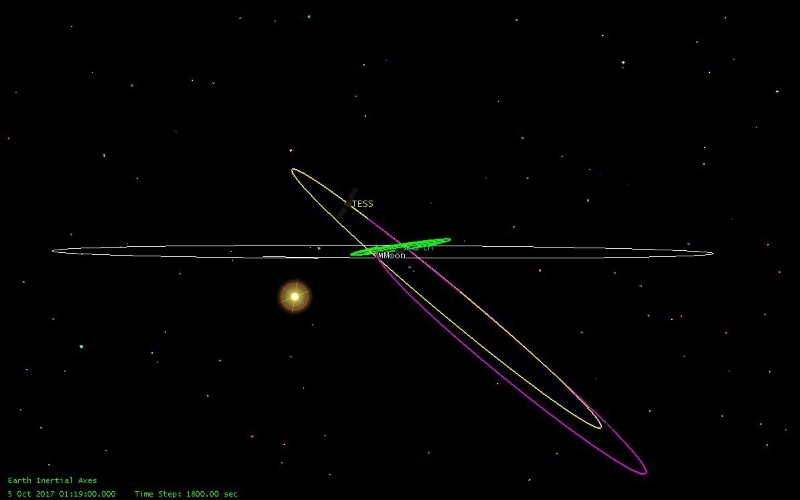 A look at the TESS orbit from the moon's orbit plane.
A look at the TESS orbit from the moon's orbit plane.And finally, from the transition orbit, the telescope will switch to the working one, at a cost of only ~ 200 m / s of the characteristic speed. And after all the maneuvers at the telescope will remain approximately 20% of the fuel.
The working orbit has an orbital period of 13.65 days, exactly half the orbital period of the moon. This was done specifically so that each orbit of the Moon was as far as possible — at 90 ° to the left or right of the apparatus and to bring at least disturbances. It is expected that the orbit will be stable (that is, it will not require fuel consumption for correction) for at least 20 years.
And the task of saving on antennas and communications equipment is solved by the fact that the orbit is quite elongated - the apocenter is about three times higher than the pericenter. In the region of the lowest point of the orbit, TESS will stop observations for a short time, turn the antenna towards Earth and transmit the data accumulated during the turn.
As expected, the telescope will be in working orbit and will begin scientific observations in two months.
Launch
It is worth noting that the launch of the telescope was a separate success for SpaceX - for the first time, the company gained access to NASA's medium-risk science missions, and TESS was the first to be removed exclusively by an American space agency — previous projects, Jason-3 and DSCOVR, were created in NASA cooperation with other organizations.
By the way, TESS became the lightest vehicle launched on the Falcon 9. But a higher reference orbit did not leave fuel to return to land, the first stage had to land on the barge. It is also expected that this mission will be the last launch of a new missile of the Block 4 modification, very soon the final, even more adapted for reusable, version of Block 5 should fly.